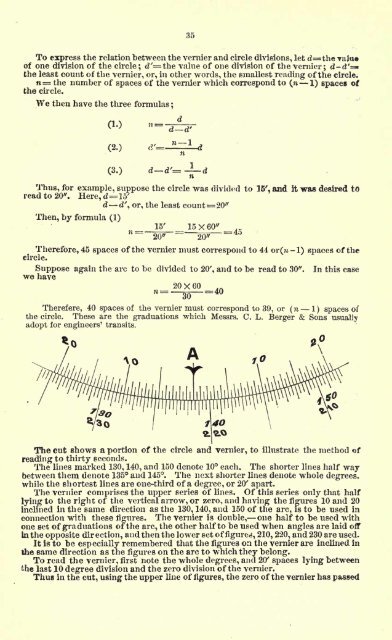STANDARD - Survey Instrument Antique Center!
STANDARD - Survey Instrument Antique Center!
STANDARD - Survey Instrument Antique Center!
Create successful ePaper yourself
Turn your PDF publications into a flip-book with our unique Google optimized e-Paper software.
35<br />
To express the relation between the vernier and circle divisions, let d=the rn tu<br />
of one division of the circle; d'=the value of one division of the vernier; d-d'=<br />
the least count of the vernier, or, in other words, the smallest reading of the circle.<br />
n= the number of spaces of the vernier which correspond to (n 1) spaces of<br />
the circle.<br />
We then have the three formulas ;<br />
(1.)<br />
(20<br />
(3.) d d'=<br />
Thug, for example, suppose the circle was divided to 15', and it was desired to<br />
read to 20". Here,d=15'<br />
d d', or, the least count:<br />
Then, by formula (1)<br />
n =45<br />
Therefore, 45 spaces of the vernier must correspond to 44 or(n-l) spaces of the<br />
circle.<br />
Suppose again the arc to be divided to 2CK, and to be read to 30". In this case<br />
we have<br />
Therefore, 40 spaces of the vernier must correspond to 39, or (n 1) spaces of<br />
the circle. These are the graduations which Messrs. C. L. Berger & Sons usually<br />
adopt for engineers' transits.<br />
2.2.0<br />
The cut fihows a portion of the circle and vernier, to illustrate the method of<br />
reading to thirty seconds.<br />
The lines marked 130, 140, and 150 denote 10 each. The shorter lines half way<br />
between them denote 135 and 145. The next shorter lines denote whole degrees,<br />
while the shortest lines are one-third of a degree, or 20 /<br />
apart.<br />
The vernier comprises the upper series of lines. Of this series only that half<br />
lying to the right of the vertical arrow, or zero, and having the figures 10 and 20<br />
inclined in the same direction as the 130, 140, and 150 of the arc, is to be used in<br />
connection with these figures. The vernier is double, one half to be used with<br />
one set of graduations of the arc, the other half to be used when angles are laid off<br />
in the opposite direction, and then the lower set offigured, 210, 220, and 230 are used.<br />
It is to be especially remembered that the figures on the vernier are inclined in<br />
the same direction as the figures on the arc to which they belong.<br />
To read the vernier, first note the whole degrees, and 20 7<br />
spaces lying between<br />
the last 10 degree division and the zero division of the vernier.<br />
Thus in the cut, using the upper line of figures, the zero of the vernier has passed


